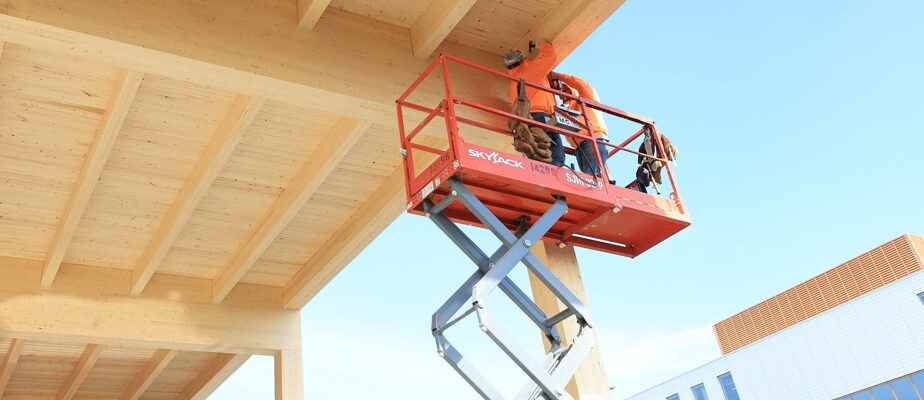61 days from the entry into force of certain provisions of the Act to modernize the occupational health and safety system (LMRSST), the CNESST is not ready, denounce employers, unions and health and safety companies in the construction industry.
Posted at 5:00 a.m.
To comply with this new law which modifies the Occupational Health and Safety Act (OHSA), new health and safety representatives must be on construction sites on 1er January. However, industry players say they do not know how these representatives will be trained, because the Commission for Standards of Equity in Occupational Health and Safety (CNESST) has not yet determined the content of the training. nor who will give it. These new health and safety representatives have not yet been selected.
“If the CNESST is not ready, let it have the wisdom to say so and ask the government for more time,” said Éric Côté, CEO of the Corporation of General Contractors of Quebec, in an interview.
The government must urgently open the law and modify this element or make a special ministerial order to say, we are not ready, we were ambitious, let’s do things as they should be.
Éric Côté, CEO of the Corporation of General Contractors of Quebec
Éric Côté maintains that the industry does not need two years, but just a few additional months to get everything in place.
Joint letter
All the employers’ associations claim that the CNESST lacks rigor and transparency in this file. In a letter sent to the Minister of Labor as well as in a joint declaration intended for the CNESST, of which The Press obtained a copy, the associations denounce the “great variation in the decisions of the CNESST” which “returned many times to its own decisions as to the broadcaster of the training”.
“All the time wasted forces the advisory committee to do things in a hurry, and that does not seem to us to be the right way to go,” write the employers’ associations.
“The disaster, we feel it coming, maintains in an interview Guillaume Houle, spokesperson for the Association de la construction du Québec (ACQ). Because the people who will be appointed in January 2023 have no training obligation. There is an incongruity in the law. It obliges training only for January 2024.”
In point one of their mandate, it is the inspection of workplaces. We are going to send people to inspect workplaces without any training.
Guillaume Houle, spokesperson for the Association de la construction du Québec, regarding health and safety representatives
The LMRSST provides for a part-time health and safety representative (RSS) on sites with 10 to 99 workers, while it provides for one or more full-time representatives on sites with 100 or more workers or whose cost of site work exceeds $12 million.
“On the eve of the entry into force of the provisions of the law, too many elements remain to be defined to ensure the full application by entrepreneurs of the mechanisms provided for in the law. We risk creating confusion, unduly slowing down the work, poisoning the working climate and risking the safety of our workers on construction sites in Quebec,” denounce the associations in the joint statement presented to the CNESST on October 20.
“We knew it since last year that the RSS had to be trained and it hasn’t been done. We could have spent the year training these people. There are already programs that exist, can we draw inspiration from them and bring them up to 2022? asks Éric Côté, who points out that contractors are currently submitting bids “a bit blind” because they cannot predict the costs and terms and conditions that will be linked to health and safety representatives. .
800 representatives to be trained
François Simard, CEO of Équipe SST, a company specializing in health and safety management on construction sites, specifies that the same number of health and safety representatives are needed as health and safety coordinators, designated by prime contractors on sites with 100 or more workers or where the cost of site work exceeds $12 million.
“We have 800 coordinators so, theoretically, we should also have 800 health and safety representatives,” he says. We won’t have time to train everyone. »

PHOTO HUGO-SÉBASTIEN AUBERT, THE PRESS
By law, new health and safety representatives must be on construction sites from 1er January.
François Simard is also concerned that the training of health and safety coordinators will stop in January 2023 and will not resume until the fall of 2023, because the new content has not yet been approved by the CNESST. “We badly need this training, because there is a lack of coordinators everywhere,” he observes.
Although the CNESST is not ready, the FTQ-Construction affirms that it will be ready in January 2023 and will support its members who request it.
“For part-time RSS, for lack of training, we can support them, give them advice or support them in their efforts,” said Simon Lévesque, head of health and safety at the FTQ-Construction, who also sits on the phone. to the board of directors of the CNESST. “For the full-time one, we had our own content that we gave to representatives on major construction sites with 500 workers or more. So we will continue to do so. »
The union wants to be able to continue to train its members, the new RSS, with the new content approved by the CNESST, while the employers’ associations would like neutral trainers.
The Press asked the CNESST if the new health and safety representatives, who are to be in place in January 2023, are ready and if they will be trained by Collège Ahuntsic as are the health and safety coordinators.
“The CNESST is currently analyzing the questions submitted by The Press and will forward the requested details in the coming days,” she wrote by email.
The CNESST adds that it says it understands the issues generated by these changes in the workplace and will do everything possible to apply the legislative changes and support employers and workers in the implementation of this law.

